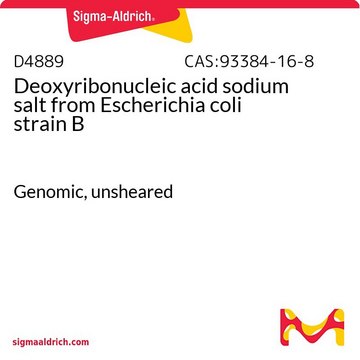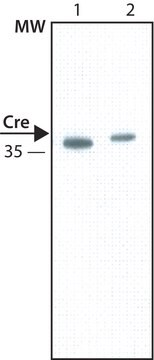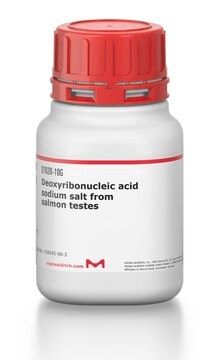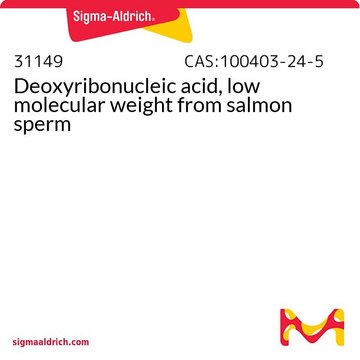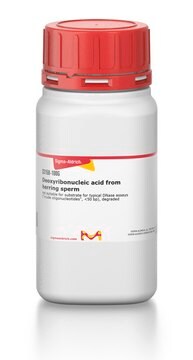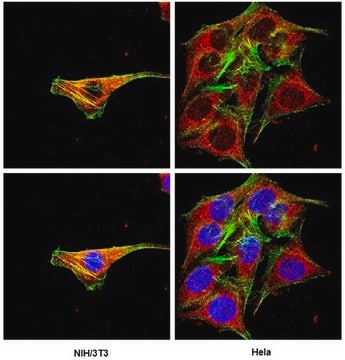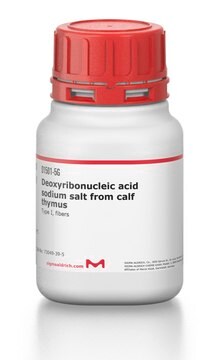추천 제품
애플리케이션
Escherichia coli DNA has many uses in research. Escherichia coli DNA (ecDNA) is used in studies of DNA binding agents that modulate DNA structure and function. E. coli DNA is used in physicochemical studies of DNA behavior in solution, and to evaluate species-specific DNA structures and binding domains. This DNA is particularly useful for genomic analysis, including PCR, library construction in bacteriophage lambda, and in heterologous pre-hybridization and hybridization protocols.
Deoxyribonucleic acid sodium salt from Escherichia coli strain B has been used to measure the melting temperature (Tm) and in differential scanning calorimetry (DSC) studies. It has also been used as a template sequence in the polymerase chain reaction (PCR).
제조 메모
Prepared by procedure of Marmur, J., J. Mol. Biol., 3, 208 (1961).
Storage Class Code
11 - Combustible Solids
WGK
WGK 3
Flash Point (°F)
Not applicable
Flash Point (°C)
Not applicable
개인 보호 장비
Eyeshields, Gloves, type N95 (US)
가장 최신 버전 중 하나를 선택하세요:
이미 열람한 고객
R Richins et al.
Biotechnology progress, 17(2), 252-257 (2001-04-21)
The Escherichia coli DNA binding protein FIS is a transcriptional modulator involved in the regulation of many cellular processes, including the activation of rRNA synthesis. High-level overproduction of FIS in early, mid, or late log cultures resulted in growth-phase- and
William G Dundon et al.
International journal of medical microbiology : IJMM, 291(6-7), 545-550 (2002-03-14)
Infection of the stomach mucosa by the gastric pathogen Helicobacter pylori is accompanied by a large infiltration of neutrophils and monocytes which are believed to contribute substantially to H. pylori-induced gastritis. A protein was identified (HP-NAP for neutrophil-activating protein from
Geoffrey S Briggs et al.
The Journal of biological chemistry, 282(17), 12353-12357 (2007-02-20)
The DNA-binding protein, RdgC, is associated with recombination and replication fork repair in Escherichia coli and with the virulence-associated, pilin antigenic variation mediated by RecA and other recombination proteins in Neisseria species. We solved the structure of the E. coli
Mitsumasa Hashimoto et al.
The Journal of biological chemistry, 278(31), 28501-28507 (2003-05-16)
Closely opposed lesions form a unique class of DNA damage that is generated by ionizing radiation. Improper repair of closely opposed lesions could lead to the formation of double strand breaks that can result in increased lethality and mutagenesis. In
Differential scanning calorimetry of bacteria
Miles CA, et al.
Microbiology, 132(4), 939-952 (1986)
자사의 과학자팀은 생명 과학, 재료 과학, 화학 합성, 크로마토그래피, 분석 및 기타 많은 영역을 포함한 모든 과학 분야에 경험이 있습니다..
고객지원팀으로 연락바랍니다.